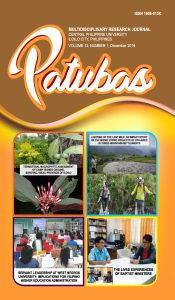
Patubas is published once a year under the auspices of Central Philippine University, Jaro, Iloilo City, Philippines.
Copyright © 2018 by individual authors and Patubas.
Published in 2018
Central Philippine University
Lopez Jaena, St., Jaro, Iloilo City
All rights reserved. No part of this publication may be reproduced or transmitted in any form or by any means, electronic or mechanical, including photocopy, recording or any information storage and retrieval system, without permission in writing from the authors or publisher.
For print ISSN 1908-515X
Publication ISSN 2672-3611
Opinions and facts contained in the articles published in this issue of Patubas are the sole responsibility of the individual authors and not of the Editorial Board, Patubas or Central Philippine University.8
Ernesto S. Elefan, MPA
Stella G. Fernandez, PhD
ABSTRACT
This study was conducted to establish baseline data on
the terrestrial macrophytes in Camp Higher Ground
(CHG), Brgy. San Nicolas, Barotac Viejo, Iloilo.
Specifically, this study determined the terrestrial
macrophyte level of plant community diversity
measured in terms of species richness, species
composition, and relative abundance, and determined
the conservation status of plant species in the area as a
logical step in protecting the threatened species from
possible extinction. The assessment was done on
September 2017 – January 2018 employing the
descriptive survey method. Data were collected from
the 1000m2 sampling area composed of 10 quadrats
each measuring 10 x 10 m2. There were 123 plant species
recorded that belong to 100 genera and 61 families.
Results revealed that trees were 56.9%; shrubs, 13.8%;
vines, 13.0%; herbs, 7.3%; ferns, 5.7%; and palms, 3.3%.
Shannon-Weinner Diversity index for CHG was high
(H’=3.867). Thirty-one, 31 (25.2%) macrophytes were
categorized threatened. Among these, two were
critically endangered: Agboi (Mussaenda philippica
L.C. Rich.) and Bugauak morado (Clerodendrum
quadriloculare (Blanco) Merr.). The endangered species
were Duklitan (Planchonella duclitan (Blco.) Bakh. f.),
Bahai (Ormosia calavensis Azaola), and Salingogon
(Cratoxylum formosum Benth & Hooker). However, 30
(24.3 %) plant species were considered endemic. During the conduct of the study, some forest clearing, wood
harvesting, and minor charcoal-making operations were
discovered which posed threats to this natural habitat
especially of threatened and endemic macrophytes.
Proper conservation program should be implemented
by the CHG management to prevent further biodiversity
loss.
Bernabe C. Pagara, Th.D.
ABSTRACT
The intent of this study is to utilize a phenomenological
qualitative paradigm to explore the lived experience of
the Baptist Ministers as full-time within the church. The
conceptual framework was shaped by the following
theories, namely: Rambo’s (1993) dialectical and
process-oriented stage model of religious conversion,
the classic and contemporary research paradigms on
conversion and transformation which focuses on
dramatic religious conversion, John L. Holland’s theory of
vocational choice on career development, Carlyle’s
great man theory of leadership, and Maslach’s (1976)
burnout theory. Data were collected using face-to-face
semi-structured interviews with four (4) pastors who are
currently leading their respective congregations. Data
collected included transcribed interviews, field notes,
and observations. Data were hand-coded to find key
concepts and themes. Five themes that emerged from
the data were: transformation of a “prodigal son”, God’s
provision and awareness of workload and responsibilities
in pastoral work, dealings with ups and downs of pastoral
work, leadership in the ministry, and receiving “manna”
as eternal gift. The results of this study contributed to a
better understanding of the factors that led to clergy
stress and burnout. The results of this study may address a
gap in literature and may result in positive social change
for both the clergy and church congregants because
the results can be used to come up with solutions on
pastoral leadership issues and for stress and burnout.
Darril F. Pamocol, M.Ed.
Rico Cezar S. Acanto, M.Eng’g.
Rodel C. Palomar, M.Ed.
ABSTRACT
This study investigated the impact of the three micro
hydro projects in three respective mountain settlements
of San Remigio Antique. Specifically it measured the
changes in the quality of life and in several
socioeconomic indicators including house structures,
average income per month, sources of income,
livelihood, cost of energy, and appliances, gadgets or
machineries among the beneficiaries. It utilized a mixed
methodology by giving a survey instrument to all 45
beneficiaries of Bunacan Micro Hydro Project, 51
beneficiaries of Culabao Micro Hydro Project and 72
beneficiaries of Maruray Micro Hydro Project, and by
conducting focused group discussions in the three
settlements. Using descriptive analysis of the quantitative
data, findings revealed improvements in the house
structures, average income per month, and in the
acquisition of appliances, gadgets or machineries
among the beneficiaries. There is a significant reduction
in energy cost despite increase in the utilization. The
cheaper cost of electricity from the micro hydro powerplant compared to the cost of using kerosene resulted to
a big cut on energy expenditures among the
beneficiaries while enjoying the opportunity to consume
more energy. Farming is retained as the main livelihood
and source of income augmented by the presence of
irrigation system and farm machineries. Thematic
analysis of the qualitative data yielded three main
themes across the categories. The impact of the micro
hydro projects into the quality of life of their beneficiaries
are happiness, empowerment and the perpetration of a
cultural practice called “dagyaw.”
George R. West, Ph.D.
Dioscoro Marañon, Jr., Victoria Cainglet,
Nony Descutido, Lourdes Magbanua,
and Cleo Grace Hinaut
ABSTRACT
Using Hale and Fields’ (2007) instrument, this study
includes the investigation of three factors relating to
servant leadership: service, humility, and shared vision;
and their relationships to outcome variables, including
affective organizational commitment and job
satisfaction, at West Negros University. The process for
the present study included following-up on a pilot study
conducted by West and Bocârnea (2008). In this present
study, 168 of 333 possible participants voluntarily
completed an associated survey. The participants
included faculty and staff members who represented all
divisions within the university. The results indicate that:
(a) shared vision contributes significantly to both
affective organizational commitment and job
satisfaction and (b) perceived organizational support
fully mediates the relationship between shared vision
and job satisfaction.
